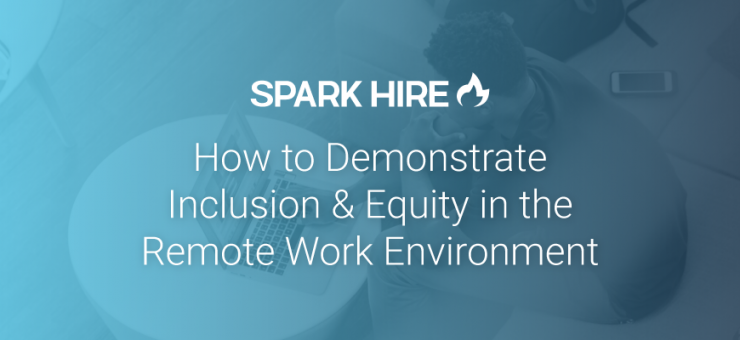Inclusion and equity in the workplace are under the spotlight more than ever. Even amid high unemployment, job seekers are looking to identify the best fit for their core values. Companies must prioritize inclusion and equity to ensure they meet candidates’ needs.
True inclusion and equity are infused into HR practices from the initial job posting through to the day-to-day of remote working. Show future and current employees how inclusion and equity are staples in your company culture.
Re-evaluate each touchpoint of job seekers and employees to make sweeping improvements to inclusion and equity for your teams:
Job Posting
The first place a job seeker interacts with your brand is the job posting, logically making it the first item to brush up. There are many tools you can use to improve this touchpoint.
Start by eliminating biased language in your job requirements. Certain words unconsciously make different groups of people more or less likely to apply for your jobs. For example, words like “see” or “climb” are examples of ableist language you should avoid. Some words skew masculine or feminine, so you need to find a balance among those. Use artificial intelligence to help you identify these kinds of words.
Additionally, take a look at exclusive job requirements. For example, does your job truly need someone to have a college degree, or will the equivalent experience be just fine? Higher education is not easy to obtain for everyone. Eliminate job requirements that are only achievable through privilege. Scale it down to what your team can’t do without.
You can also use your job postings as an opportunity to showcase your inclusion and equity efforts for employees. Add a section that talks about the inclusive culture of your remote team. Take it a step further with photos and videos illustrating what you describe. Give job seekers the ability to picture themselves as part of your team.
Sourcing
Everyone has unconscious biases. Set your recruitment team up with unconscious bias training to help them be more aware. You can do this through an online course, hiring a consultant, or by creating your own training course.
This training will help bring awareness to how candidates can inadvertently be discriminated against during the sourcing process. Once your team is conscious of individual biases, you can work against them together to ensure you’re not missing out on top talent.
Another way to make inclusion easier while sourcing is to use tools that expand your search terms. Keyword generators help recruiters see what terms they might be missing in candidate searches. This can eliminate bias because it opens you up to words and phrases you hadn’t considered to meet your job requirements. You never know what ideas you’re missing.
Lastly, sourcing should include time spent seeking out candidates from diverse organizations who may not think to apply to your company. If you never vary the places from which you source candidates, your talent pool will continue to look the same. Branch out of your comfort zone to reach job seekers from different backgrounds.
Resume/Application Review Process
If you have too narrow an idea in mind of what a candidate’s resume should look like, you may be ruling out quality applicants.
Use artificial intelligence tools designed to combat biased resume reviews. Study after study has proven people are biased in their resume reviews. From picking resumes by the sound of a name to gravitating toward people from the same background, recruiters often reveal their biases in this step.
Application tracking systems (ATS) and resume ranking software can ensure you see candidates based on their relevant skills over anything else. You can train an ATS to look for all of those relevant search terms you discovered in the sourcing process and find the best candidates for the job.
Additionally, when you share a slate of resumes with your hiring manager, make sure to tell them why you picked candidates who might not exactly match their expectations. Don’t assume hiring managers have had the same unconscious bias training as your recruitment team. Explain the benefits of each applicant so the hiring manager can see what you see in them.
Interviewing
Interviews are a key time to make a candidate feel they’ll belong at your organization. Take time to describe your team’s remote work culture and how the candidate will fit into your company.
Be transparent. Share your team’s inclusion and equity practices when you talk about the culture. Explain how things have changed since going remote and how you’re working to make everyone feel included in this new environment.
Most importantly, talk about the real changes you’ve seen on your team as a result of your inclusion and equity practices. Anyone can talk about their policies, but an equitable company respects the values of every person’s background to bring employees together.
Proven examples of ways you’ve adjusted your workflow to make everyone feel included can help a candidate picture themselves on your team.
Job Offer
The biggest way equity plays a role in your job offer is in the salary offer. Employers need to play an active role in eliminating the wage gap.
According to the most recent Census Bureau data from 2018, women of all races earn, on average, just 82 cents for every $1 earned by men of all races. Broken down by race, the gap is even wider. Black women only earn 62 cents for every dollar, Indigenous women earn 57 cents, and Hispanic and Latina women earn 54 cents.
Make sure your salary practices are fair and equitable. Never base a candidate’s salary on the salary from their most recent job. This causes folks to move through their careers at a lower pay rate. Instead, your initial offer should match the market for the role and the candidate’s experience. Be open to negotiating.
Onboarding
Starting a new job, completely remotely can be hard. On top of training a new hire on all of their responsibilities, spend time ensuring they feel included.
Develop an onboarding plan that alternates between learning the role of getting to know the team. Introducing new employees to the team’s remote work culture will help them feel excited and empowered to do their job. Set time for new hires to get to know the team as a group and as individuals. Starting them off with a celebration will make them feel welcome and included.
Make sure your remote onboarding plan can also be adjusted for different accessibility options if needed. Everyone’s work-from-home set-ups are a bit different and not everyone has the same capabilities. Be flexible with your onboarding plan to be sure every employee feels comfortable when they start with your team.
Remote Workflow
Virtual work can be incredibly isolating. In fact, one in five remote workers struggles with loneliness, according to a 2020 report from Buffer. Your inclusion and equity work can help your team feel less, well, remote.
Develop a strategy for connecting with your team. Employees need both one-on-one time and team time to feel valued at work.
Leaders should establish recurring meetings with each team member to check in on both their workload and their wellbeing. While it’s natural to want to focus on the tasks at hand, it’s important to discuss mental health and wellbeing. This balance will make employees feel more valued as human beings.
With new hires, one-on-one check-ins should occur more frequently. For the first month, meet at least weekly. The longer they’re on the team, these check-ins can be adjusted to bi-weekly and then monthly. The dedicated attention will help employees feel like their contributions matter and their voices will be heard.
When it comes to team time in remote work, leaders can infuse inclusion and equity in many ways. Bring your team together every month to celebrate successes and lift each other up. Make it easy for them to reach out to each other and collaborate. These are all ways to ensure they feel seen and heard.
Additionally, if you imagine how your team interacted in the office, you’ll recall there used to be opportunities to chat casually by the water cooler or in the break room. These experiences go away with remote work, so you need to replace them with an alternative. Give your employees a space to chat, such as a dedicated channel for “random” discussions. This gives employees yet another opportunity to feel included in the workplace.












